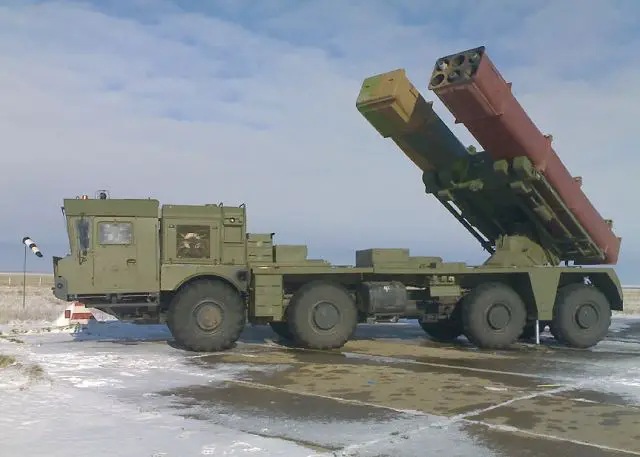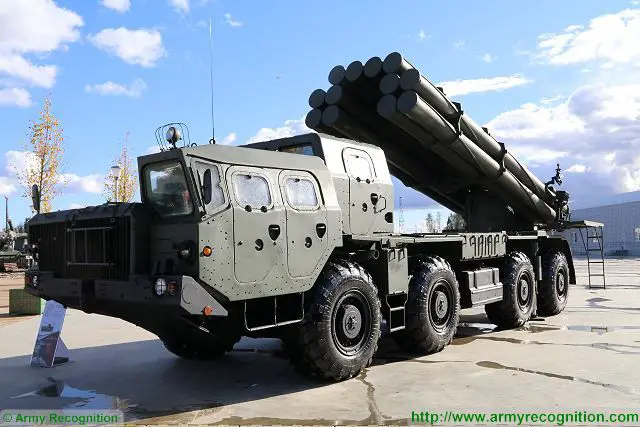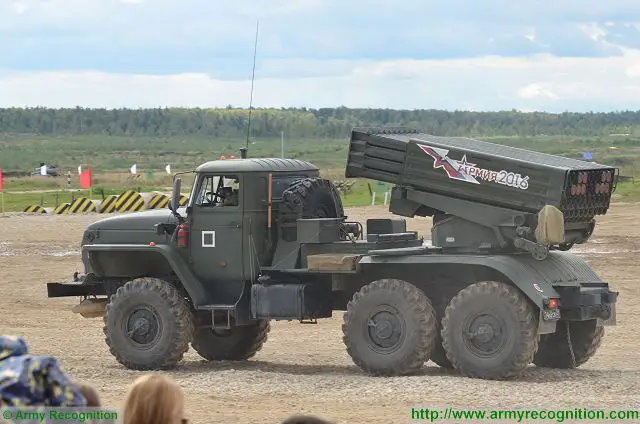|
|
|||
|
Defence & Security News - Russia
|
|||
|
|
|||
| The number of MLRS Multiple Launch Rocket System will grow in the Russian armed forces. | |||
|
The orders for multiple launch rocket systems (MLRS) placed by Russia`s Ministry of Defense (MoD) will be growing, according to the Deputy Defense Minister, Yury Borisov. The Russian Armed Forces will start to take the delivery of the newest Tornado-S MLRS in 2017, according to the Head of the dedicated directorate of the MoD`s Department for the Implementation of the State Defense Order (Russian acronym: GOZ, Gosoboronzakaz), Mikhail Osyko.
|
|||
|
|
|||
 New Uragan-1M MLRS Multiple Launch Rocket System New Uragan-1M MLRS Multiple Launch Rocket System |
|||
|
|
|||
|
"The Splav research-scientific company is doing a lot for the MoD. It is developing the state-of-the-art MLRS weapons. The military authorities are discussing the 2017 orders for MLRS. I suppose that the volume of orders will be growing through 2025. The MLRS developed by Splav have a huge export potential. I think that the company will be improving its financial metrics," Borisov said in mid-September. The Splav company is producing Grad, Uragan, and Smerch multiple launch rocket systems.
Borisov said that Russia`s Armed Forces had started to take the deliveries of the newest Uragan-1M MLRS. "The Russian military is receiving the Uragan-1M multiple launch rocket systems, however, in insufficient numbers," he said. Borisov pointed out that the tenderers of the Splav company had faced several troubles in efforts to implement the order for the Uragan-1M MLRS. The official added that the issue would be solved in order to deliver all ordered systems to the Russian military. |
|||
|
|
|||
|
|
|||
|
"The 220 mm Uragan-1M MLRS was brought into service in 2016 after the implementation of the state trials program, as well as the 300 mm Tornado-S system," Osyko said. He reminded that the contract for the delivery of the Tornado-S systems and rockets for them to the MoD had been signed at the Army 2016 military-technical forum held outside Moscow in September 2016.
"The military will the delivery of the [Tornado-S - TASS] in 2017," Osyko pointed out. Previously, Borisov said that the serial production of the Tornado-S multiple launch rocket systems would commence in 2017. According to him, the system would receive high-precision rockets and an advanced automatic command-and-control (C2) system. The effective firing range of the Tornado-S would be significantly increased over the previously developed MLRS, Borisov pointed out. Previously, the official said that the MoD was planning to procure approximately 700 multiple launch rocket systems (MLRS) by 2020. "Motovilikha (the Motovilikhinskie Zavody company) produces three types of MLRS on serial basis, namely, 'Tornado-G', 'Uragan' and 'Tornado-S" systems. There are huge procurement amounts under the State Defense Order program. We are to buy approximately 700 multiple launch rocket systems," Borisov said in April 2016. |
|||
|
|
|||
|
|
|||
|
It is noteworthy that the MoD is paying a special attention to the further development of the TOS-1A Solntsepyok self-propelled heavy flamethrower [TOS-1A is often described as a multiple launch rocket system - TASS]. Borisov said that the trials of an updated variant of TOS-1A system would commence in 2017. "In 2017, we are to finish the design works in order to develop an advanced self-propelled heavy flamethrower under the Tosochka program. Once the relevant trials have been completed, we will start the serial production of the new weapon, I suppose," Borisov said.
The MoD and the Splav company are finishing the trials of a unique long-range rocket intended for the TOS-1A heavy self-propelled flamethrower, according to the Izvestia newspaper. The new rocket will be able to destroy enemy's engineer installations, manpower, and armoured vehicles at distances up to 10,000 m, Izvestia said. The full technical specifications of the munition are not disclosed. "At present, the trials of the newest rocket [for TOS-1A - TASS] are being carried out. We are planning to finish the test program before the year-end. The munition has retained the dimensions of the previous rocket, namely, M0.1.01.04M rocket developed by the Splav company. At the same time, we have increased the new rocket's firing range and combat effectiveness of the thermobaric warhead," a source in the defense industry told Izvestia. |
|||
|
|
|||
|
|
|||
|
An official representative of the Splav company confirmed the trials of the new rocket. However, he decided not to comment the program.
"Solntsepyok is essentially an assault vehicle that provides fire support to the infantry on the battlefield. To prevent damage by enemy, the system is based on a tank chassis," a military historian, Alexey Khlopotov told Izvestia. A source in the Russian defense industry told the newspaper that the task to create a new rocket for the Solntsepyok system was a very difficult one. "The dimensions of the self-propelled vehicle and the launching tube remained the basic ones. Therefore, we could not increase the new rocket`s length and weight. Usually developers reduce the weight of fuel or warhead in such case. On the contrary, we have developed new types of fuel and explosive compound. The new rocket has the dimensions of its predecessor, while the firing range and blast effect have been increased," a source in the MoD told Izvestia. The TOS-1A self-propelled heavy flamethrower has a range of 400-6000 m and a full salvo time of 6 sec (for 24 unguided rockets). The vehicle has a combat weight of 44.3 t and a crew of three servicemen. Using rockets with thermobaric warheads significantly increases the vehicle`s firepower against enemy`s personnel group targets. The system was developed by the Omsktransmash company (a subsidiary of the Uralvagonzavod scientific-production corporation). It can be installed on T-72A or T-90 main battle tanks. |
|||
|
|
|||
 Russian-made BM-30 Smerch 300mm MLRS Multiple Launch Rocket System Russian-made BM-30 Smerch 300mm MLRS Multiple Launch Rocket System |
|||
|
|
|||
|
According to the Military Balance 2016 report issued by the International Institute for Strategic Studies (IISS), as of early 2016, Russia`s Land Forces deployed about 850 multiple launch rocket systems, including about 550 122 mm 9K51 BM-21 Grad and its modifications, 200 220 mm 9P40 Uragan, and about 100 300 mm 9A52 Smerch systems. About 150 BM-21 Grads have been upgraded to 9K51M Tornado-G MLRS, which has an effective firing range of 40 km and can fire three types of unguided rockets and one type of guided missile. The combat effectiveness of Tornado-G has been increased by 15 times over basic BM-21, according to several reports.
9P140 Uragan has an effective firing range of 38 km. It fires rockets with high-explosive (HE), thermobaric, cluster or incendiary warheads. 9A52 Smerch is one of the most effective MLRS systems in the world. It is armed with 12 launching tubes. Seven types of rockets are available. The maximum effective firing range of Smerch reaches 90 km. It is one of the most long-range MLRS in the world. Only Chinese WS-1B has longer fire range (reportedly 180 km). There is no official confirmation of the aforementioned specification of the Chinese MLRS, while Smerch has already revealed its high combat performance. Russian Armed Forces are receiving new multiple launch rocket systems designated as Uragan-1M. It is equipped with launching canisters, suitable for rockets of two calibers (220 mm and 300 mm, respectively). It is supposed to be supplied to Russian Armed Forces in 2016-2017. Uragan-1M will reportedly have an effective firing range of 120 km. |
|||
|
|
|||
|
© Copyright 2016 TASS. All rights reserved. This material may not be published, broadcast, rewritten or redistributed.
|
|||
The number of MLRS Multiple Launch Rocket System will grow in the Russian armed forces TASS 10210163
- Posted On






![It is noteworthy that the MoD is paying a special attention to the further development of the TOS-1A Solntsepyok self-propelled heavy flamethrower [TOS-1A is often described as a multiple launch rocket system - TASS].](/images/stories/news/2016/october/The_number_of_MLRS_Multiple_Launch_Rocket_System_will_grow_in_the_Russian_armed_forces_640_004.jpg)
![It is noteworthy that the MoD is paying a special attention to the further development of the TOS-1A Solntsepyok self-propelled heavy flamethrower [TOS-1A is often described as a multiple launch rocket system - TASS].](/images/stories/news/2016/october/The_number_of_MLRS_Multiple_Launch_Rocket_System_will_grow_in_the_Russian_armed_forces_640_003.jpg)









